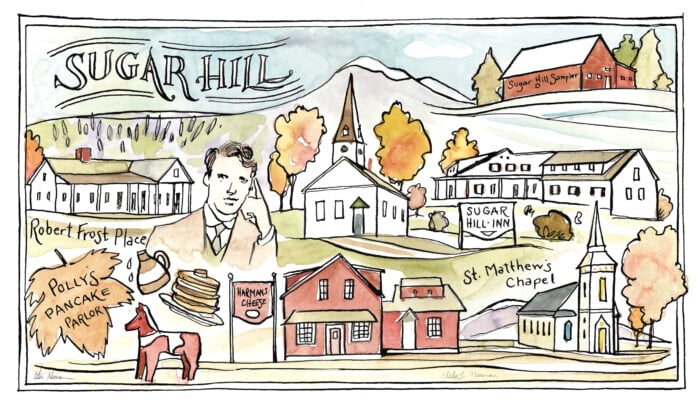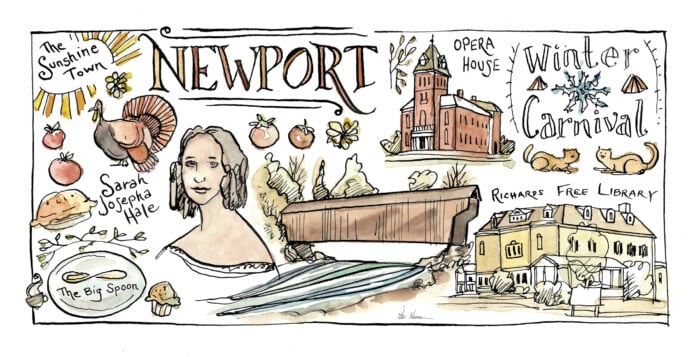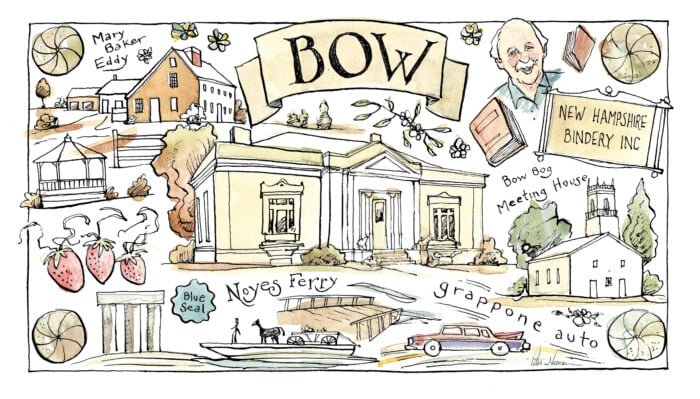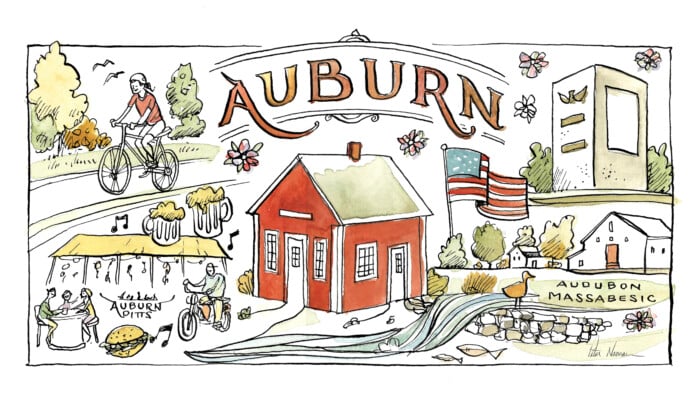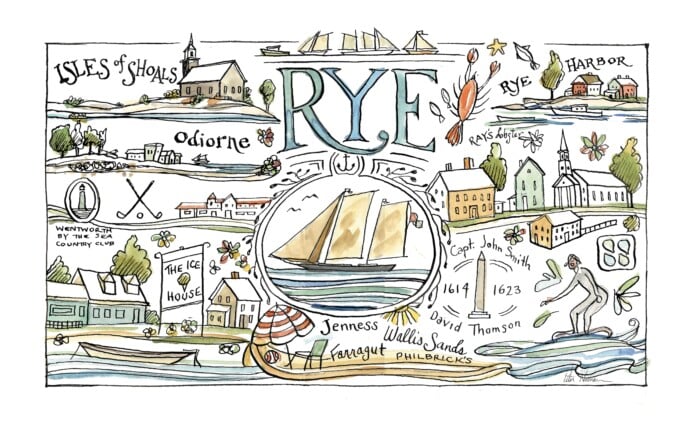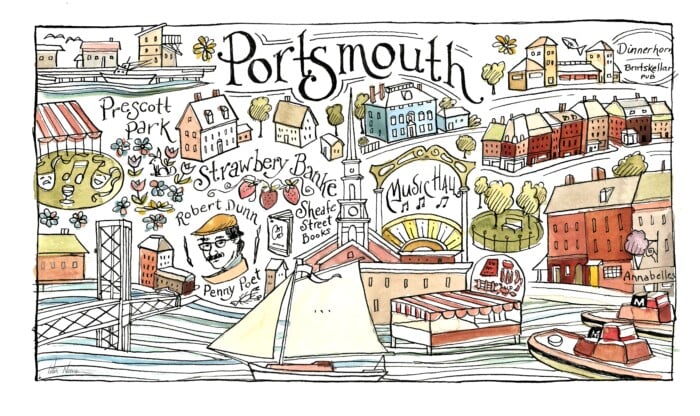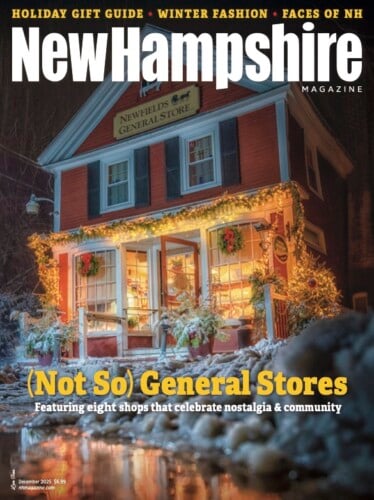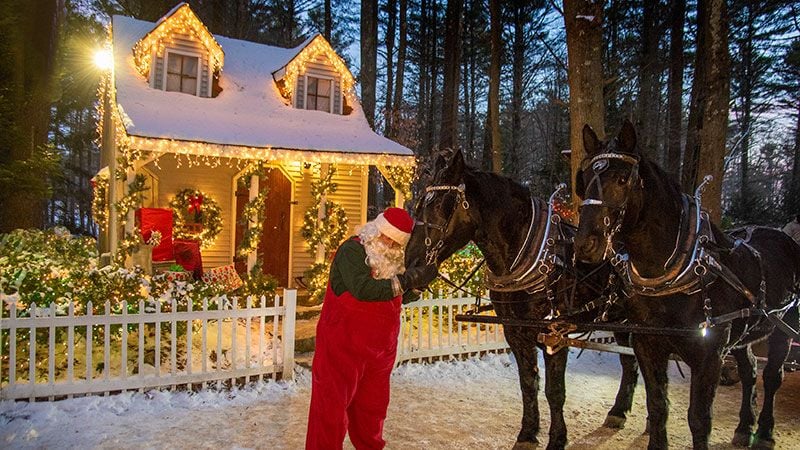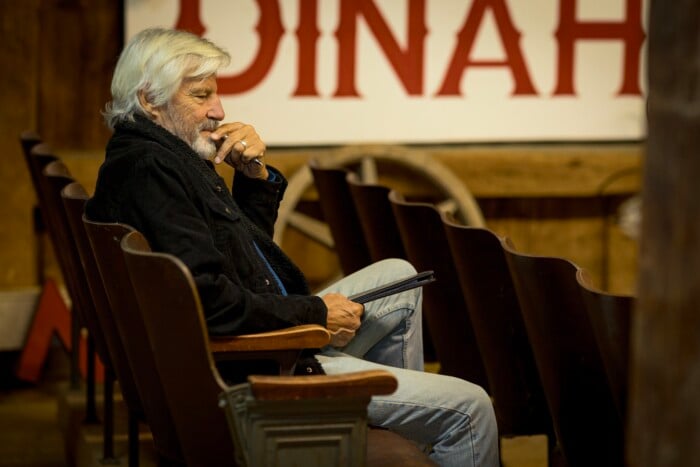Stopping for Ducks and Scarecrows in Auburn
Auburn, New Hampshire retains its small-town charm, but growth is on the horizon for the community-oriented town
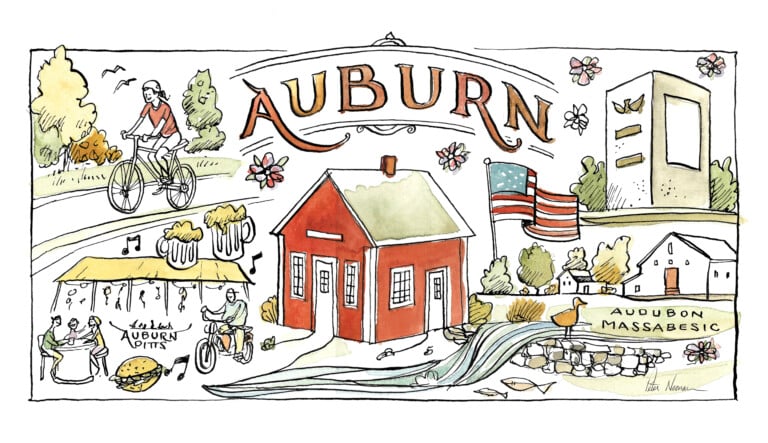
Every year about this time, a strange migration pattern brings 3,000 ducks to the center of Auburn.
Alex Herlihy, the town historian, who also spent many years as a history teacher before that, knows a thing or two.
Forecasters this year say the birds will arrive Sept. 13, between 10 a.m. and 3 p.m. — just in time for Auburn Day and the 32nd annual Duck Race.
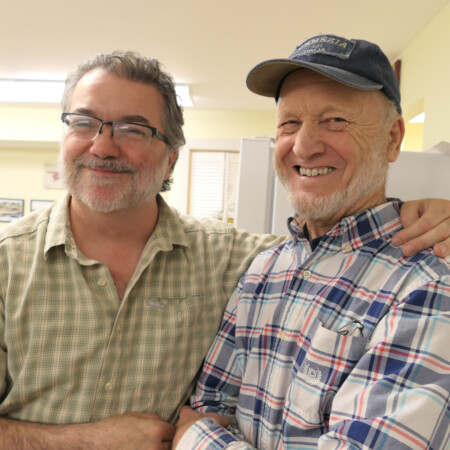
Dan Szczesny, director of the Griffin Free Public Library, and Dan Carpenter, president of the Auburn Historical Association.
Dan Carpenter, president of the Auburn Historical Association, shares a secret. The ducks, all of them sporting a strange bright yellow hue, already have been captured and put inside the 1855 Hearse House, last used as a horse-drawn hearse in 1914.
The ducks don’t actually fly. Instead, they sort of drift in the water and then careen over the Griffin Mill Waterfall until they reach the finish line. Of course, there are some athletes who veer off-course and get stuck in a bank or the lane lines.
That’s where the duck wrangler steps in. He can’t touch the competitors, so he swirls his arms in the water to create a current and dislodges swimmers. Scores of people from Auburn and other locales buy tickets and hope their numbered floatie crosses the finish line first, second or third for cash prizes.
It’s the kind of family fun you’ll find only in a small community like Auburn.
Another type of invasion hits town less than a month later. The scarecrow interlopers are a hodgepodge group of strangers, some scary, others wary and many just trying to do their jobs.
Auburn’s Jennie Frulla earned a first-place last year for a well-done kayaker sporting a smile and a broad-brimmed hat while paddling a decked-out canoe across the front lawn. One that still makes people laugh is a mustached police scarecrow in uniform conducting speed checks, holding out a radar to clock passing vehicles.
Growing, but no traffic lights
Auburn is at an intersection, and it’s not because the town doesn’t have a single traffic light. In a social media shout-out asking residents what they loved most about their town, an outpouring followed within minutes — with both delight and dismay.

With its stunning vistas and well-maintained walking trails, Lake Massabesic is a popular spot for residents of Auburn and surrounding towns. Pictured here is Front Park, off Londonderry Turnpike at sunrise.
“The small community where everyone knew everyone else and generations from the same family lived in the community — sadly those days are pretty well gone now,” Roy Thomas said. “It’s lots of things. In the end, the town has more newcomers than not at this point, since it’s now considered a bedroom community to Massachusetts.
The town has become too pricey for locals who grew up there to afford to stay, he says.
“Taxes have risen and have hurt the elderly. It is what it is and isn’t going to change unfortunately,” Thomas said. “Personally, as someone whose family has lived there for four generations, I’m looking at places further north at this point.”
There’s growing concern about changing landscapes, including an influx of people from other states and Gove Group Real Estate’s Cliffs at Evergreen, a multiphase 55-and-older condo complex set to include 79 units near Exit 2. Prices go from the mid-$700,000s to mid-$800,000s. A map indicated there were 30 units sold and another 21 pending. (Gove Group didn’t answer phones calls and messages about the project.)
In Auburn, some are optimistic about the added tax revenue for the town, but others wonder about the emotional cost of expansion.
A relative newcomer, Kate Tarbox moved here six years ago and says she knew right away she wanted to live here “forever.”
“We love the small-town feel, but not being too far from everything you need. The location is about as perfect as it gets,” she said. “The lake, the trails, the farms and land folks have, and the people – it’s a special place and I truly hope that it stays this way. Less cookie-cutter developments will help preserve the charm (hint hint).”
Arising from Massabesic
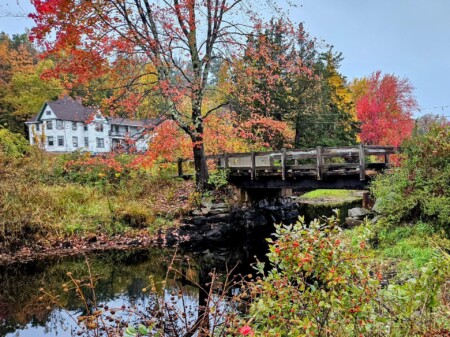
The historic Griffin Homestead is situated at Maple Falls Brook (aka Sucker Brook),
home to the finish line for Auburn Day’s Duck Race.
Native Americans established a fishing settlement they called “Massabesic,” the same name newcomers came to call the lake, which provides water to several communities and gives people a picturesque place to sail, kayak, fish and enjoy recreational trails.
British settlers set foot here in 1720, and there was relative peace until the 1754 French and Indian War. The settlement was obliterated. Chester — also known as Chester Woods, Chester West Parish and Long Meadow, took over the land. It was incorporated as Auburn in 1845.
Massabesic was a huge tourist draw in the late 1800s and early 1900s, with the Concord & Portsmouth Railroad — later rebranded as the Portsmouth branch of the Boston & Main Railroad — dropping and picking up passengers from a small depot. Hotels and boat landings dotted the landscape around the lake, but today, most are gone, victims of fire. Use of the railroad system dwindled in the mid-1900s, and after the last freight trains passed through in the early 1980s, the tracks were ripped out.
As of the 2000 census, 4,682 people lived in Auburn. The latest United States Census estimate for the town is 6,263. Auburn includes 28.7 square miles, made up of 25.2 square miles of land and 3.5 square miles of water.
NH Audubon’s Massabesic Center operates a 49-acre wildlife sanctuary adjacent to land owned by Manchester Water Works that extends north to Battery Point, featuring trails to the lake frequented by hikers and cross-country skiers.
Deb Mancini said she lived in Manchester for 30 years before moving to Auburn.
“I love the wildlife here — from the herons, loons and an occasional eagle on the lake to the woodpeckers and bluebirds in our yard,” Mancini said. “You always have to watch out for turtles crossing the roads to get to the ponds. I enjoy hearing the barred owls and even the coyotes at night.”
Community kindness
Bicentennial Park stretches across a long length of grass that turns into a blanket of yellow, oranges and reds in the fall and benches to take in the water. Monuments nearby pay tribute to Auburn men who served in the Civil War between 1861 and 1865. Others honor those who served in World War I and II and the Korean and Vietnam wars.
This is the type of community where people don’t walk by with eyes glued to the ground. They line up in the town hallway and catch up with other residents as they wait to pay a tax bill or register a vehicle.
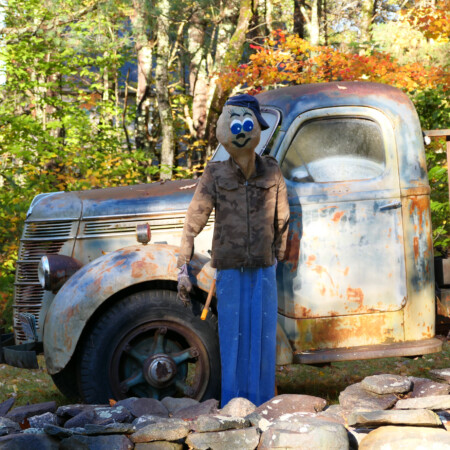
Auburn’s annual scarecrow contest inspires residents like Justin Carpenter, who created this scene, to populate their yards with new neighbors.
“After my Mom passed, all the neighbors still check on Dad and invite him out for lunch at least once a month,” said Trina McLaughlin-Abbott.
Wooded trails, like the one off Chester Turnpike, and one around Tower Hill Pond, get people on their bikes, into walking shoes and running even faster during black fly season. Stone walls, farm animals, barns, vistas, hikes, history, nature and lake views remain big draws.
Denise Pineault is an avid walker who never misses a chance to make a friend.
“I can’t count how many times I have been walking and everyone I know stops to talk to me, or they’re in their yards and we chat in their driveways,” she said. “They want to see how we’re doing and I want to see how they are doing, and the next thing we know, we have a get-together.
“Now there’s a community center where there are exercise classes. There are more trips planned for seniors. They have more arts and crafts, and I believe it will help with the spirit of the town.”
Greek on the menu
Auburn is home to a handful of eateries, including some local favorites. Both the Auburn Tavern, 346 Hooksett Road, and the Auburn House of Pizza, 15 Chester Road, have added a bit of Greek flair to favorites.
The Tavern’s menu includes souvlaki marinated pork skewers with tzatziki dipping sauce; Shrimp Sagannaki, a Greek appetizer with shrimp sauteed with garlic, tomato and feta cheeses and topped with ouzo liquor; and Avgolemono chicken lemon rice soup.
At the House of Pizza, the menu includes Mykonos pizza with tomato, feta cheese, red onions and black olives; Santorini pizza with spinach and feta; and baklava, a layered pastry dessert made of filo pastry, filled with chopped nuts and sweetened with syrup or honey.
Auburn Pitts Bar and Grill, 167 Rockingham Road, is where you go for tried-and-true American fare: hot dogs, cheeseburgers, wings for dipping, onion rings, grilled cheese, BLTs, fries, chips, nachos, fried mozzarella, chili, subs and wrap, pizza and steak bombs.
In the back there’s a backyard fire pit along with horseshoe and cornhole games and music. It was at the Pitts that a celebration of life for former Auburn Fire Chief Bruce Phillips, an Auburn native who died at 68, took place recently.
For on-the-go places, there’s Dunkin’, and across the street, Myles Travel Plaza, where there is a Burger King and Alltown Fresh fare.
Meanwhile, there’s been talk of a new Pizza Place, Nana’s Kitchen and Pizzeria, going into the industrial plaza on Dartmouth Road, down the street from the Pitts. Renovations continue, so an opening date hasn’t yet been announced.
Read this (for free)
There are ways to keep the past alive and evolve at the same time — and you don’t need an enormous library to do it, said director Dan Szczesny. The founder of the Griffin Free Public Library, Sebastian Griffin, was a pioneer of the Free Library movement in the late 19th century, and he donated his collection and the first library building to Auburn in 1893. Residents and those who work in Auburn get free library cards.

The Griffin Free Library is a popular spot for kids. From left: Molly Thiboult,
Luke Connor, Josie Thiboult and Lilly Connor.
“Our front event room is the original structure,” said Szczesny, a long-time journalist and book author who started working at the library part-time as an assistant in 2014. “The room still has its tin roof. Our circulation room and kids’ room were built and added on in 1895. Pretty much nothing changed after that for 110 years until a new side room, offices and a bathroom expanded our footprint in 2005.”
Despite its small footprint, the library offers an array of services, including links to search its catalog, download and stream items, borrow material from other New Hampshire libraries, and access E-books, audiobooks, movies and magazines.
“We are still, per capita to town size, the smallest library in the state,” Szczesny said.


